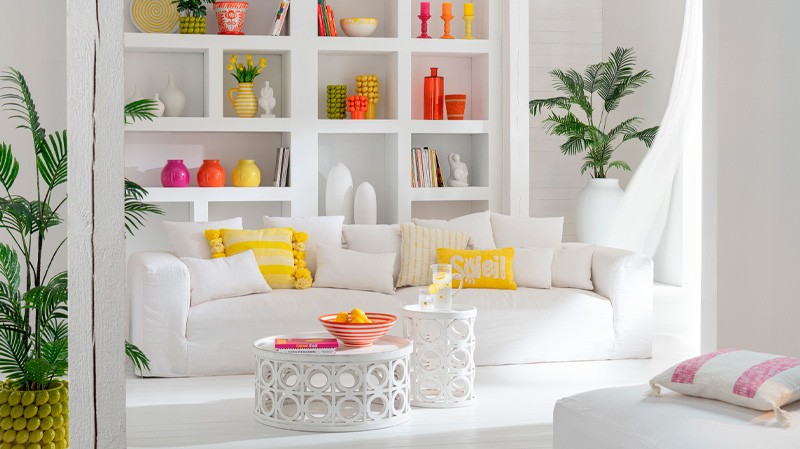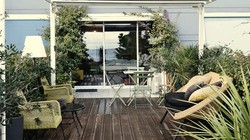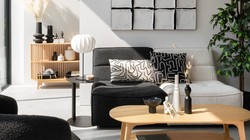How to arrange living room furniture according to its shape
Distributing the furniture we want in a room can sometimes be a challenge. There are many barriers that we can encounter when choosing the furniture and its distribution for a living room.
In this post we tell you everything you need to know to distribute the furniture in the living room in the best way. Keep reading!

What to consider before arranging furniture?
Before choosing and arranging the furniture in the living room, you should take into account some key aspects that will influence your decision. These are the size and proportion of the living room, the focal points and structural elements, and also the circulation and functionality of the space. We will tell you more about each of them:
Size and proportion of the living room
The size and proportion of the living room are key. It is important to know the space in which we want to place the furniture well, so as not to choose furniture or elements that are too large or too small. Knowing the dimensions of the space in which you are moving is really important. So is its proportion.
Focal points and structural elements
The focal point is the element that will be the focus of the attention of the people who live in the space. In most living rooms, the focal point is the television, but it can also be a fireplace, for example.
Structural elements are part of the construction of the space, so they must be taken into account when thinking about the furniture that we are going to use for the living room. Some of the structural elements that are usually necessary are walls, pillars or sloping ceilings, for example.
Focal points will be the center of the room, so choose where to place them – if possible – and have the rest of the furniture placed around them.
Circulation and functionality
When choosing furniture for a room, and especially when placing it, it is essential to keep in mind that the space must be functional. It is essential to avoid furniture blocking the room, so that it is possible to continue moving around normally.
Furniture layout according to the shape of the living room
The shape of the living room is essential to know how to place the furniture in it. Here are some tips to know how you can place the furniture in your living room according to its shape:
Rectangular living room
In a rectangular living room, place the sofa along one of the longest walls. If you want to create a conversation area, you can add armchairs and poufs in front of the sofa. Place a coffee table, circular, square or rectangular, between the sofa and the armchairs. The wall opposite the sofa will be the focal point of the room, so place a television or other elements such as a fireplace or a bookshelf. Finally, it is an open space, you can place a dining table at the other end of the living room.
Square living room
The square living room can also have a sofa and armchairs surrounding a coffee table. This will create a geometric layout. As it is a square room, it is important to make the most of the space, such as the corners, with shelves or floor lamps, but without introducing too many elements. Finally, place the television or fireplace on one of the walls, but in the centre, to maintain visual balance.
L-Shaped Living Room
For an L-shaped living room, use the longer section for the sofa and a coffee table, and the shorter section for an armchair or reading area. If you want to visually separate the room, use rugs or open shelving. The shorter section can serve as a dining area if space allows.
U-shaped living room
A U-shaped living room also requires a focal point, which can be a coffee table or a fireplace, and which should be located in the center of the U. Sofas can go on the long legs of the U, and an armchair at the bottom that will help close the space. The television can be placed on one of the short walls or on a swivel cabinet to give visibility from different angles.
Small or narrow living room
The size of a small or narrow living room requires the use of small, multi-functional furniture. It is advisable to use a linear layout, placing the sofa against a long wall to avoid blocking the space. In this type of room, mirrors will help create the illusion of a larger space. Finally, it is also advisable to use floating shelves and tables, so that floor space is freed up and space is gained.
Living room with irregular floor plan
For living rooms with irregular floor plan, the first recommendation is to divide the living room into specific areas using visual boundaries, such as plants, rugs or low furniture. Opt for modular furniture that you can rearrange and relocate depending on the needs that arise in the space. As for focal points, use prominent pieces, such as paintings, sculptures or lamps, to draw attention to different parts of the living room.
Tips for a harmonious and functional layout
In addition to the general guidelines for creating these layouts, below we detail some tips for achieving a visually harmonious and, above all, functional layout of the space.
It is important to prioritize the flow of movement, that is, leave enough free space for people to move easily and without obstacles.
The choice of furniture should be made in proportion to the size of the room, that is, do not choose large furniture for small rooms or small furniture for large rooms.
It is also important, especially on a visual level, to distribute the furniture in a balanced way to avoid one side of the room looking more crowded than the other.
Prioritize functionality over aesthetics. Each piece of furniture should have a clear purpose and facilitate daily activities.
Place furniture so that it doesn't block windows or doors, so that it doesn't obstruct the entry of natural light or access to doors.
Finally, use decorative elements to add personality to the room, but be careful not to overload it. These elements can be cushions, paintings, plants or lamps.
We hope we have helped you and don't forget to follow us on Instagram and Facebook!




Receive our news